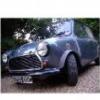
Lead loading/soldering
#1

Posted 14 June 2007 - 09:24 AM
One question I do have is that in the little handbook I got, it says to heat the solder with acytelene torch, I'm guessing this only serves to melt the solder, and therefore would a blow torch suffice?
#2

Posted 14 June 2007 - 11:04 AM
#3

Posted 14 June 2007 - 11:08 AM
#4

Posted 14 June 2007 - 11:15 AM
Think its a different gas from butane.
#5

Posted 14 June 2007 - 11:30 AM
#6

Posted 14 June 2007 - 12:10 PM
You can get extra hot blow torches I think roofers use them on lead repairs.
Think its a different gas from butane.
Yes, it's acetylene! Funny that!
It'll take ages to melt thick lead stock properly with a butane/propane setup. That's why solder is (or was) lead/tin, so it melts at a lower temperature. Should work though but you will have to expose the panels to heat for longer to do it so you may end up distorting them.
#7

Posted 14 June 2007 - 12:24 PM
You want a wide, gentle, hot flame NOT a concentrated flame like you get with a propane torch or welding torch. There are special torch heads for acetylene that produce this wide flame with minimal or no added oxygen. You have to use a flame that is rich so you deposit carbon (if anything). A lean flame will re-oxidize the surface making it nearly impossible to tin the surface. Surface prep is the most important thing. Absolutely no rust, oil, grease, dirt, etc.
I saved a link for an impressive restoration using lead work. See:
http://www.mckennasgarage.com/xke/
Scroll down to the bodywork and leadworking pages.
Regarding toxicity, it is a poison, I don't know about it being a carcenogin. I think the other ill effects of high lead levels in your blood will kill you long before you develop cancer from it. My suggestion, do the heavy filling with lead then FILE it down (filing, NOT sanding) to the general shape and finally fill in the file marks with a thin coat of regular plastic filler. It may sound counter-intuitive, but it really isn't. Lead is a great filler for high build repairs that may flex... whereas the plastic filler will crack in those situations.
Don't forget to wash the leaded area thoroughly with sudsy ammonia when you're done to neutralize the acid in the tinning butter.
#8

Posted 14 June 2007 - 12:28 PM
Funny just looked at mine it contains METHYL-ACETYLENE-PROPADINE in a yellow tin.You can get extra hot blow torches I think roofers use them on lead repairs.
Think its a different gas from butane.
Yes, it's acetylene! Funny that!
It'll take ages to melt thick lead stock properly with a butane/propane setup. That's why solder is (or was) lead/tin, so it melts at a lower temperature. Should work though but you will have to expose the panels to heat for longer to do it so you may end up distorting them.
#9

Posted 14 June 2007 - 12:36 PM
That's MAPP gas. It will burn hotter than propane but not as hot as acetylene. Repeating what I said above, it has to be a soft, gentle flame more than just hot. You need the right torch head regardless of what gas you're using.
Edited by dklawson, 14 June 2007 - 12:37 PM.
#10

Posted 14 June 2007 - 01:05 PM
Thanks for the help guys!
#11

Posted 14 June 2007 - 01:23 PM
#12

Posted 14 June 2007 - 01:30 PM
#13

Posted 14 June 2007 - 03:43 PM
I used plumbers flux on the area first, then used a butane torch, worked great.
#14

Posted 14 June 2007 - 04:11 PM
Presumably the kit that Jammy bought has tinning-butter in it. That's lead/tin loaded flux. Using that you won't need the separate flux we're talking about.
Before you buy the acetylene torch, try the propane you probably already have. If you unscrew the head of the torch you'll find a metering orifice. If you take that out and carefully adjust the flow control knob you should be able to develop an fat undefined flame. You won't get the nice conical tip you're used to with a normal propane torch. The softer flame is what you want.
#15

Posted 14 June 2007 - 06:21 PM
Well said, I would hate to see anyone sighn up for a £500 a year contract on oxy acy with boc when they can use that other gas.Like FatMini and Jack_Marshall, I've used acid flux, steel wool, and a propane torch for the task. It can be done that way without too much trouble. However, you'll still need the maple paddles and the lard or whatever lube they tell you to put on the paddles.
Presumably the kit that Jammy bought has tinning-butter in it. That's lead/tin loaded flux. Using that you won't need the separate flux we're talking about.
Before you buy the acetylene torch, try the propane you probably already have. If you unscrew the head of the torch you'll find a metering orifice. If you take that out and carefully adjust the flow control knob you should be able to develop an fat undefined flame. You won't get the nice conical tip you're used to with a normal propane torch. The softer flame is what you want.
1 user(s) are reading this topic
0 members, 1 guests, 0 anonymous users




















